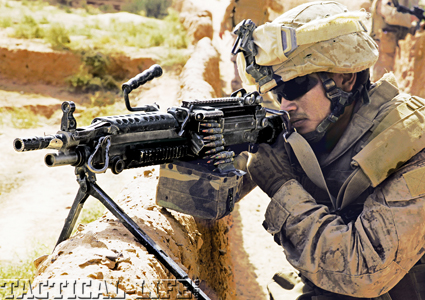I remember the first time I handled an M249 Light Machine Gun, which was generally called the SAW (Squad Automatic Weapon) at the time. I was at Ft. Lewis, Washington, doing a training course for the Military Police SRT (Special Reaction Team). We were doing building clearing exercises in a tire house, the snow crunching beneath our feet as we moved through the scenarios. Between exercises, we observed a lot of tracer rounds going down range nearby, so on our way back to the SRT HQ to debrief we stopped to see what was going on. Troops from either the 9th Infantry Division or the 2/75th Rangers—I don’t remember which as this was more than 20 years ago—were shooting the SAW, and I got a chance to handle and shoot one. I had fired an FN Minimi, the LMG upon which the M249 is based, prior to this occasion but at Ft. Lewis was the first time I encountered the U.S. version up close.
The M249 was introduced into U.S. units in 1984 to give the infantry squad a portable automatic weapon capable of accurately delivering a lot of rounds down range. Gas-operated and air-cooled, the M249 fires from an open bolt and has a quick-change design to rapidly switch out an overheated barrel, or one with a stuck cartridge case or that is otherwise unserviceable. Because the barrel is light, it overheats quickly which results in key-holing of bullets after a couple of hundred rounds fired on full auto. As a result, many experienced M249 gunners carry two spare barrels rather than one. Although most M249 gunners rely on the bipod to maintain portability, an M192 LMG tripod is available if the M249 is positioned in a static defensive position.

Belt Or Magazine Fed
Although the M249 is fed primarily by linked ammunition, it also has the capability of taking M4/M16 magazines. Ability to take magazines from the standard squad rifle is a plus as it allows their use should the gunner run out of linked ammo. To be honest, though, in a firefight, most troops aren’t gong to be giving away the magazines they’ve humped into combat and, arguably, they will be able to deliver more sustained aimed fire if they keep them. Use of M4/M16 magazines in the M249 also batters the magazines so that they may cause malfunctions if used later in a rifle. Also, when used in the M249, the rifle magazine generally will have trouble feeding fast enough to match the M249’s cyclic rate of 750-1,000 rounds per minute. In fact, the cyclic rate actually increases when a rifle magazine is used, as no energy is being used to feed the belt. Still, some M249 gunners seem to prefer carrying their LMG with a 20-round magazine in place rather than a belt.
Advertisement — Continue Reading Below























